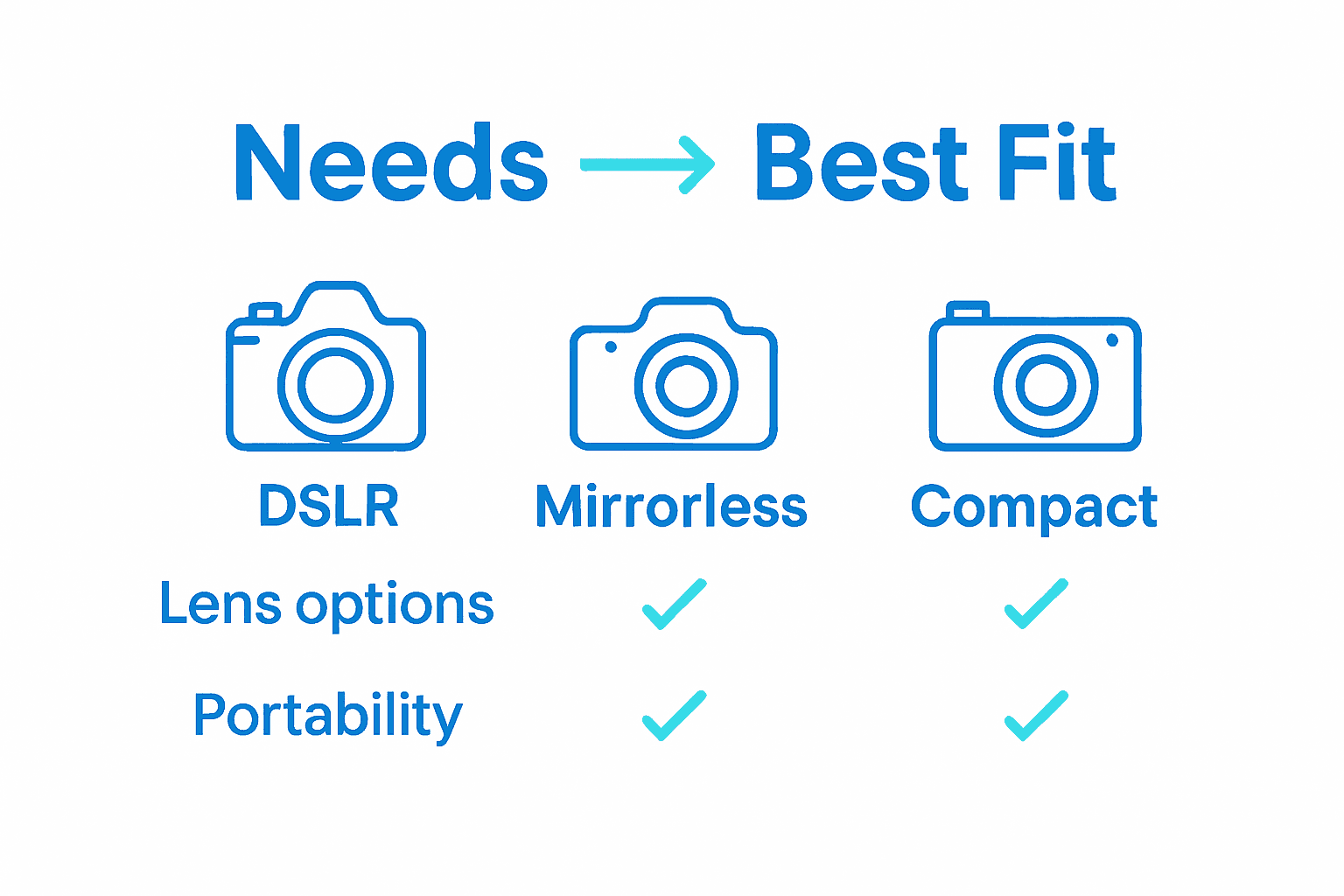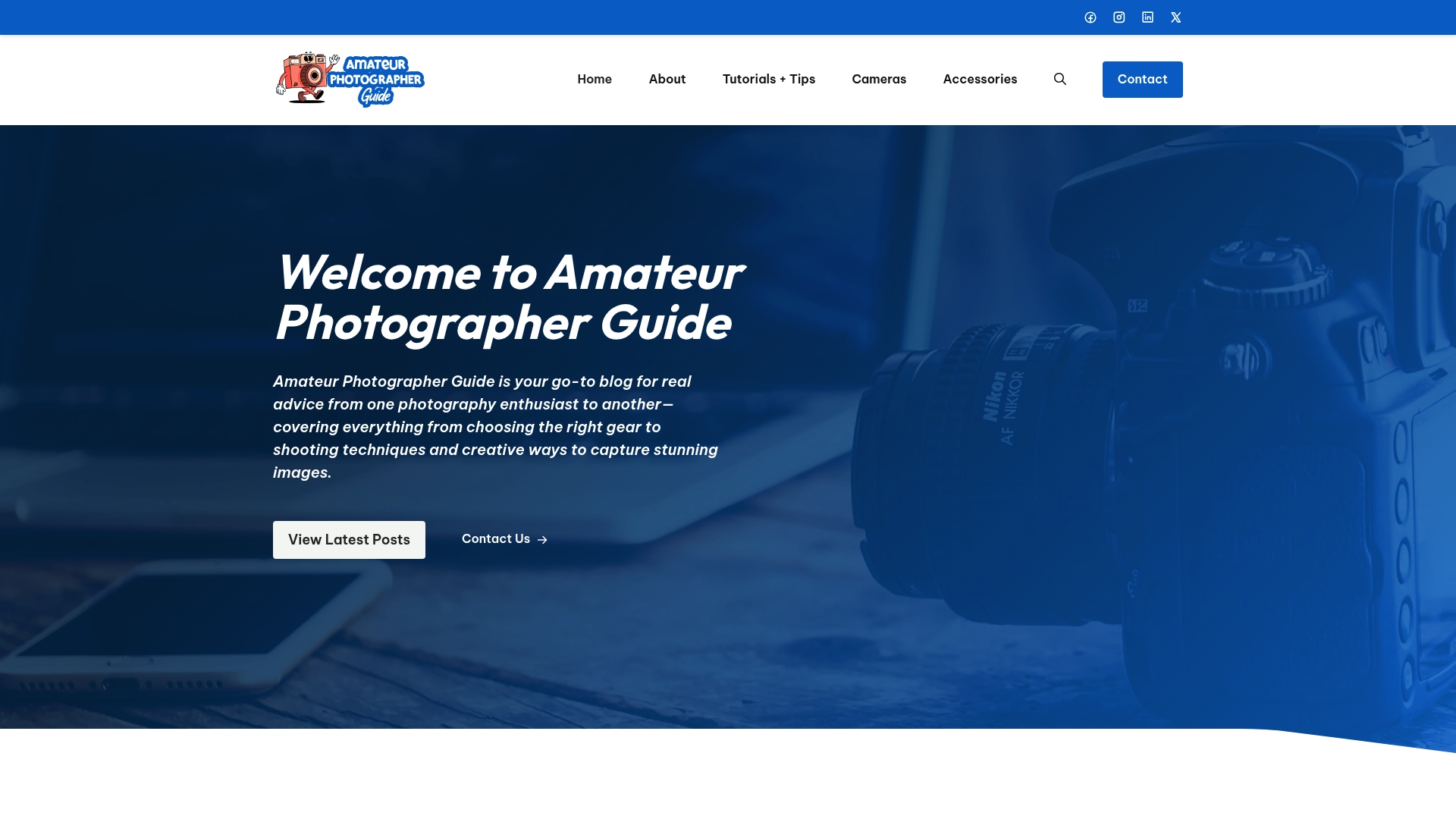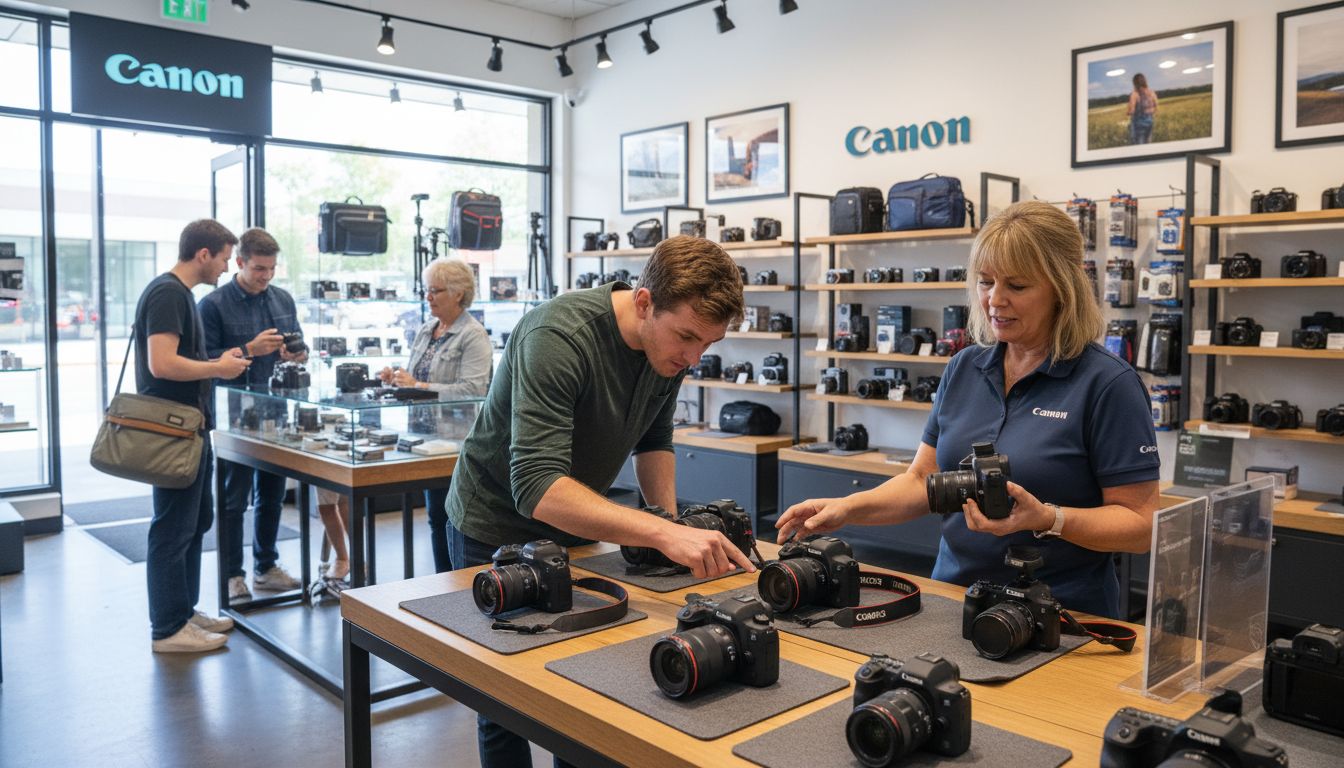Table of Contents
- Quick Summary
- Step 1: Assess Your Photography Needs and Budget
- Step 2: Identify Key Camera Features to Match Your Goals
- Step 3: Compare Popular Camera Types and Models
- Step 4: Test and Evaluate Cameras Before Purchasing
- Step 5: Verify Your Choice Aligns With Your Photography Plans
- Find the Camera That Truly Matches Your Vision
- Frequently Asked Questions
- Recommended
This blog post may contain affiliate links. As an Amazon Associate I earn from qualifying purchases.
Over 60 percent of beginner photographers admit to feeling confused when trying to choose their first camera. With so many models, features, and technical terms, it is easy to feel lost or second guess your decision. Matching your camera choice to your true needs means every shot brings you closer to your creative goals without wasting a single dollar. This guide shows you how to turn your hopes and budget into the perfect camera for your next adventure.
Quick Summary
| Key Point | Explanation |
|---|---|
| 1. Assess your photography needs and budget | Reflect on your goals and financial limits to choose a suitable camera without overspending. |
| 2. Identify key camera features | Understand vital specifications like sensor size and autofocus to align with your photography style. |
| 3. Compare camera types and models | Explore different categories like DSLR and mirrorless to find a model that suits your needs. |
| 4. Test cameras in person | Hands-on evaluation helps you understand how the camera feels and performs in various conditions. |
| 5. Verify the choice aligns with your plans | Ensure the camera meets your photographic goals and enhances your creative expression. |
Step 1: Assess Your Photography Needs and Budget
Choosing the right camera starts with honest self reflection about your photography goals and financial reality. This step helps you narrow down options and prevent wasting money on equipment that does not match your actual needs.
Begin by asking yourself critical questions about your photographic journey. What subjects fascinate you most? Are you interested in landscapes, portraits, wildlife, street photography, or documentary work? Each specialty demands different camera features and capabilities. If you primarily want to capture family moments, a compact point and shoot might work perfectly.
 For serious wildlife photography, you will need a camera with robust zoom capabilities and high speed autofocus.
For serious wildlife photography, you will need a camera with robust zoom capabilities and high speed autofocus.
Your budget matters just as much as your creative vision. Professional cameras can range from $500 to over $5000, so understanding your financial limits is crucial. How to Choose a Camera for Amateur Photographers Easily can provide additional guidance. Consider not just the camera body cost, but also potential expenses for lenses, memory cards, extra batteries, and protective gear. A good rule of thumb is to allocate about 30% of your total budget for accessories beyond the initial camera purchase.
Warning: Do not get seduced by marketing hype or the most expensive gear. The best camera is the one you will actually use consistently and understand thoroughly. Start with something that matches your current skill level and budget, knowing you can upgrade later as your skills improve.
Step 2: Identify Key Camera Features to Match Your Goals
Understanding camera features is crucial to finding the perfect tool for your photographic ambitions. This step will help you decode technical specifications and match them to your specific shooting requirements.
Start by examining key technical capabilities that directly impact image quality and performance. Image sensor size plays a critical role in determining picture clarity and low light performance. Larger sensors typically capture more light and detail, which becomes essential for professional quality shots. Buying A Digital Camera: 7 Important Things To Look For can provide additional context about sensor considerations. Modern research highlights how advanced sensor technologies can dramatically improve image aesthetics and performance, particularly in challenging lighting conditions.
Consider your specific photography needs when evaluating features. For wildlife or sports photography, look for cameras with high burst rates and fast autofocus. Low light photographers should prioritize cameras with excellent noise reduction capabilities. Landscape photographers might focus on dynamic range and color reproduction. Image stabilization becomes crucial if you frequently shoot in motion or without tripod support. Research from mobile photography studies underscores how features like noise reduction can transform image quality in challenging environments.
Warning: Technical specifications can be overwhelming. Do not get paralyzed by endless comparisons. Focus on features that directly support your specific photography goals and skill level. A camera packed with advanced features means little if it does not feel comfortable and intuitive in your hands.
Step 3: Compare Popular Camera Types and Models
Navigating the world of camera types can feel like exploring a complex landscape with countless options. This step will help you understand the key differences between camera models and find the perfect match for your photography style.
The primary camera categories you will encounter are DSLR, mirrorless, point and shoot, and advanced compact cameras. DSLR or Mirrorless: Which Camera Actually Fits Your Photography Style? provides an excellent deep dive into these categories. DSLRs offer robust build quality and exceptional lens interchangeability. They excel in professional settings with reliable performance. Mirrorless cameras are lighter, more compact, and increasingly popular among travel and street photographers. They provide electronic viewfinders and silent shooting modes that DSLRs cannot match.
Research in camera identification technologies reveals unique optical characteristics that distinguish different camera models. Point and shoot cameras work best for casual photographers wanting simplicity. Advanced compact cameras provide more manual controls and better image sensors for enthusiasts seeking higher quality without professional camera complexity. When comparing models, pay attention to specific features like sensor size, autofocus speed, low light performance, and ergonomics. Your ideal camera should feel like a natural extension of your creative vision.

Warning: Do not get overwhelmed by technical specifications. A camera is only as good as its ability to capture the moments that matter to you. Test different models in person. Handle them. See which one feels most intuitive and comfortable in your hands.
Step 4: Test and Evaluate Cameras Before Purchasing
Buying a camera is a personal journey that requires hands on experience and careful evaluation. This step will guide you through testing and comparing cameras to ensure you make the most informed decision possible.
How to Select Camera Gear for Stunning Photos suggests several practical strategies for comprehensive camera evaluation. Visit local camera stores or photography shops where you can physically handle different models. Pay attention to how the camera feels in your hands. Check the weight distribution. Test the button placement and menu navigation. Take sample shots in various lighting conditions to understand the camera performance. Zooming, focusing, and adjusting settings should feel intuitive and comfortable.
Research indicates that understanding a camera’s unique characteristics requires more than surface level testing. Take multiple test shots using different modes. Examine image quality at various ISO settings. Check autofocus speed and accuracy. Some stores offer rental programs that allow extended testing periods. Online reviews and professional comparisons provide additional insights into camera performance across different shooting scenarios. Pay special attention to how the camera handles low light conditions and rapid movement.
Warning: Do not rush your decision. A camera is an investment in your creative potential. Trust your instincts. If a camera does not feel right after thorough testing. Keep searching. The perfect camera should inspire you to capture moments and tell stories.
Step 5: Verify Your Choice Aligns With Your Photography Plans
Choosing a camera is more than a technical decision. It is about finding a creative tool that transforms your unique vision into compelling visual stories. This final verification step ensures your camera becomes a true extension of your photographic aspirations.
How Planning Ahead Is The Key To A Great Photo Shoot highlights the importance of strategic preparation in photography. Reflect deeply on your specific photographic goals. Are you pursuing landscape photography that demands high dynamic range? Shooting wildlife requiring rapid autofocus? Capturing street scenes needing compact and discreet equipment? Each photography genre demands unique camera capabilities. Create a detailed checklist comparing your selected camera against your anticipated shooting scenarios. Consider factors like lens compatibility, low light performance, weight, portability, and specialized features relevant to your preferred photography style.
Drawing inspiration from philosophical perspectives on photography from scholars like Susan Sontag and Roland Barthes. Photography transcends mere technical reproduction. Your camera should resonate with your emotional and artistic intentions. Imagine the stories you want to tell. Visualize the moments you hope to capture. Does this camera feel like a natural conduit for your creative expression? Trust your intuition. A perfect camera connection goes beyond specifications. It is about finding an instrument that understands and amplifies your unique perspective.
Warning: Do not compromise your creative vision for marginal cost savings. A camera that partially meets your needs will ultimately frustrate your photographic journey. Invest in equipment that genuinely inspires and empowers your artistic exploration.
Find the Camera That Truly Matches Your Vision
Choosing the perfect camera can feel overwhelming with so many technical terms and options like sensor size, autofocus speed, and camera types. The real challenge is finding gear that fits your unique photography goals and budget without getting lost in confusing specs. Whether you want to capture breathtaking landscapes, fast-moving wildlife, or memorable family moments, understanding these key factors is crucial.

Start your journey with confidence by exploring Amateur Photographer Guide, where practical advice and easy-to-understand tutorials help you cut through the noise. Discover how to match your vision with the right features, compare cameras like DSLR and mirrorless, and take the guesswork out of testing gear before you buy. Don’t settle for a camera that doesn’t inspire you right now. Visit Amateur Photographer Guide and let us guide you every step of the way to your perfect camera choice.
Frequently Asked Questions
How do I assess my photography needs before buying a camera?
Start by reflecting on your photography goals and the subjects that interest you most. Ask key questions about what types of photography you want to pursue, such as landscapes, portraits, or wildlife, as each requires different camera features.
What key camera features should I look for to match my photography style?
Identify features that impact image quality, such as sensor size, autofocus speed, and low light performance, depending on your specific photography needs. For instance, if you’re focusing on wildlife photography, prioritize cameras with fast burst rates.
How can I compare different camera types effectively?
Familiarize yourself with the main camera categories such as DSLR, mirrorless, and point-and-shoot. Test each type in person to see which aligns best with your shooting style and comfort level, noting differences in weight, handling, and features.
What should I do when testing and evaluating cameras?
Physically handle different camera models in-store to assess how they feel, checking button placement and menu navigation. Take sample shots in various lighting conditions to evaluate image quality and performance; if possible, rent a camera for more in-depth testing.
How can I ensure my camera choice aligns with my photography plans?
Create a checklist that matches your selected camera’s features against your expected shooting scenarios. Consider factors like lens compatibility and portability, to ensure the camera complements your creative vision and photographic goals.
What budget should I set for my camera purchase?
Determine your overall budget early on, considering not just the camera body but also lenses, memory cards, and accessories. A good rule of thumb is to allocate about 30% of your total budget for these additional items to ensure you have everything needed for optimal use.
Recommended
- Buying A Digital Camera: 7 Important Things To Look For – Amateur Photographer Guide
- How to Select Camera Gear for Stunning Photos – Amateur Photographer Guide
- 7 Things To Look For When Buying A Digital Camera – Amateur Photographer Guide
- How to Choose a Camera for Amateur Photographers Easily – Amateur Photographer Guide

